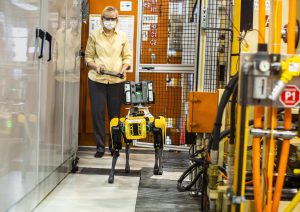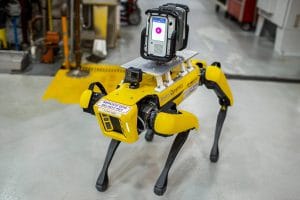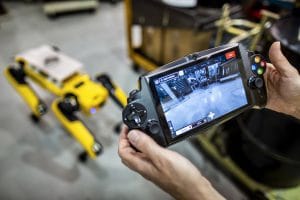Their names may be “Fluffy,” and “Spot,” but don’t expect to see workers spending time petting the “dogs” Ford plans to unleash at its Van Dyke Transmission Plant in suburban Detroit next month.
That’s because they’re actually robots developed by Boston Dynamics, a company known for developing animal-like machines featuring remarkable levels of agility and mobility. Each are equipped with five separate cameras and will wander around scanning the entire plant floor.
“We design and build the plant. After that, over the years, changes are made that rarely get documented,” said Mark Goderis, Ford’s digital engineering manager. “By having the robots scan our facility, we can see what it actually looks like now and build a new engineering model. That digital model is then used when we need to retool the plant for new products.”
(For pumps Mustang Mach-E up to 1,400 hp with track car.)
The traditional process for keeping track of changes at a plant requires sending out a team of human employees equipped with tripod-mounted laser devices. It’s slow and cumbersome, typically taking two weeks and costing $300,000 per plant, according to Ford.

Paula Wiebelhaus, Fluffy’s handler, navigates the dog-like robot through tough-to-reach areas within the plant.
“With Fluffy’s help, we are able to do it in half the time,” said Goderis, noting that this will help the company prepare for future updates, allowing it to launch new products more quickly.
There are other advantages, added Paula Wiebelhaus, the handler for the two robots. “There are areas in the plant that you might not want to walk into because they might be tough to maneuver. It’s easier and safer to send Fluffy back there.”
While not quite lifelike, Fluffy and Spot bear a striking resemblance to real dogs, at least in the way they move – Boston Dynamics specializing in making animal-like robots. Bright yellow and black, and powered by lithium-ion batteries that can operate for up to two hours at a time, Wiebelhaus guides the robots using a drone-style controller through which she sees what each robot’s cameras are looking at.
(Ford partnering with Mobileye to expand ADAS efforts.)
Each of the robots can move at speeds up to 3 mph, and each has three operational gaits, notes Boston Dynamices. They can walk on stable ground, “amble” on uneven pavement, and even negotiate stairs. They even can stretch to enter particularly tight and narrow locations, and they’re able to stand back up should they fall.
Automobile plants typically are among the most automated factories in the world, though most of their robots are little more than pre-programmed arms that spin and turn as they load parts, operate welding guns or apply adhesives.
“Fluffy is an amazing manufacturing tool,” said Weibelhaus. “Yes, it’s interesting and new, but Fluffy should really be valued for his work and tenacity. He can do so much more than dance and roll over. We want to push him to the limits in the manufacturing plant and see what value he has for the company.”
Ford has been looking for other ways to expand robotics beyond the assembly line. It has experimented with a two-legged design, dubbed Digit, to deliver packages and other goods around a plant. And it worked with automatic company to develop “co-bots” that could assist human workers on the line at its plant in Cologne, Germany.
(Ford rejects call to abandon police vehicle market.)
The second-largest Detroit automaker isn’t alone. A number of domestic and foreign manufacturers are similarly experimenting with more life-like robots that could take on even more jobs in the car plants of the future.


